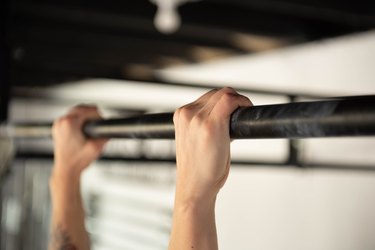
Pull-ups are one of the most intimidating exercises out there. Not only is it impressive to be able to heave your entire body weight up to the bar, but once you start stringing multiple reps together? You may as well legally change your name to Superman or Superwoman.
Granted, the pull-up isn't the only exercise out there that involves pulling, which is one of the foundational movement patterns, according to the American Council on Exercise (ACE). While other at-home exercises like push-ups, squats and lunges can build enviable strength, pulling is often ignored says Mike Whitfield, a trainer, weight-loss coach and author of Rise and Hustle.
Video of the Day
Video of the Day
According to an April 2013 study from the International Journal of Sports Physical Therapy, researchers found that people were 1.5 to 2.7 times stronger in pushing than they were for pulling. This kind of imbalance can be exacerbated due to a sedentary lifestyle and eventually lead to injuries.
Read more: 10 Exercises to Help You Conquer the Pull-Up
While there are ways to adjust body-weight moves to involve more back strength, an easier solution is just $20 away: a doorway pull-up bar. Without any tools or making holes in the walls, these bars can be hung on any standard doorframe. Using the bar to perform chin-ups and pull-ups each day can help increase back strength, improve your posture and even strengthen your grip, which is correlated with a longer life, according to a July 2015 study published in The Lancet.
A Pull-Up Bar Workout for Strength Training at Home
Try this four-move circuit from Whitfield for a full-body workout that takes just 15 minutes. Perform each exercise for the given reps, and then move to the next exercise with as little rest as possible. Continue cycling through the four moves until 15 minutes have passed.
Over time, work on improving the number of total sets you can finish. But be sure to stay safe, Whitfield says. "One good rule of thumb: If you feel you won't [or can't] give a set your best effort with perfect form, you need to rest."
Move 1: Chin-Up
- Hang from the bar with an underhand grip (palms facing you), hands about shoulder-width apart.
- Keep your shoulders back and down. Pull your chin toward the bar by bending your elbows.
- To help engage your back, concentrate on bringing your elbows down to touch your lats instead of thinking about bringing your chin over the bar.
- Return to the start position, and repeat.
- Perform 3 repetitions short of failure in each set. (In other words, if you can do 10 chin-ups, stop at 7.)
Tip
Can’t do a chin-up? Start with negative chin-ups. Grab the bar with an underhand grip and jump to the top of the chin-up. Descend as slowly as you can until your arms are straight. Perform the move in this way until you can do “regular” reps.
Move 2: Push-Up
- Start in a high plank with your hands beneath your shoulders and your body forming a straight line from head to heels.
- Bend your elbows to lower your chest toward the floor.
- Press back to start.
- Perform 3 repetitions short of failure in each set.
Tip
If regular push-ups are too hard, find a step, bench or the arm of a sofa, and perform elevated push-ups with your body angling up (hands on the step, bench, sofa, etc.).
Move 3: Split Squat
- Stand with your right foot about three feet in front of your left.
- Keeping your torso upright, bend your knees until they form 90-degree angles, your front knee over your ankle.
- Press back to standing.
- Perform 12 reps on each side in each set. Perform all 12 reps before you switch legs and repeat.
Move 4: Mountain Climber
- Start in a high plank.
- Lift your right foot and bend your knee to bring it up toward your right shoulder.
- Return it to the start, and repeat with the left leg. That's one rep.
- Rapidly exchange in this way. Perform 10 reps on each side in each set.
Tip
For more abdominal work with your mountain climbers, try Whitfield's tip: Perform the move slowly to really challenge your abs.
- International Journal of Sports Physical Therapy: "Upper Body Push and Pull Strength Ratio in Recreationally Active Adults"
- The Lancet: "Prognostic Value of Grip Strength: Findings From the Prospective Urban Rural Epidemiology (PURE) Study"
- American Council on Exercise: "Training Movements, Not Muscles"
Was this article helpful?
150 Characters Max
0/150
Thank you for sharing!
Thank you for your feedback!